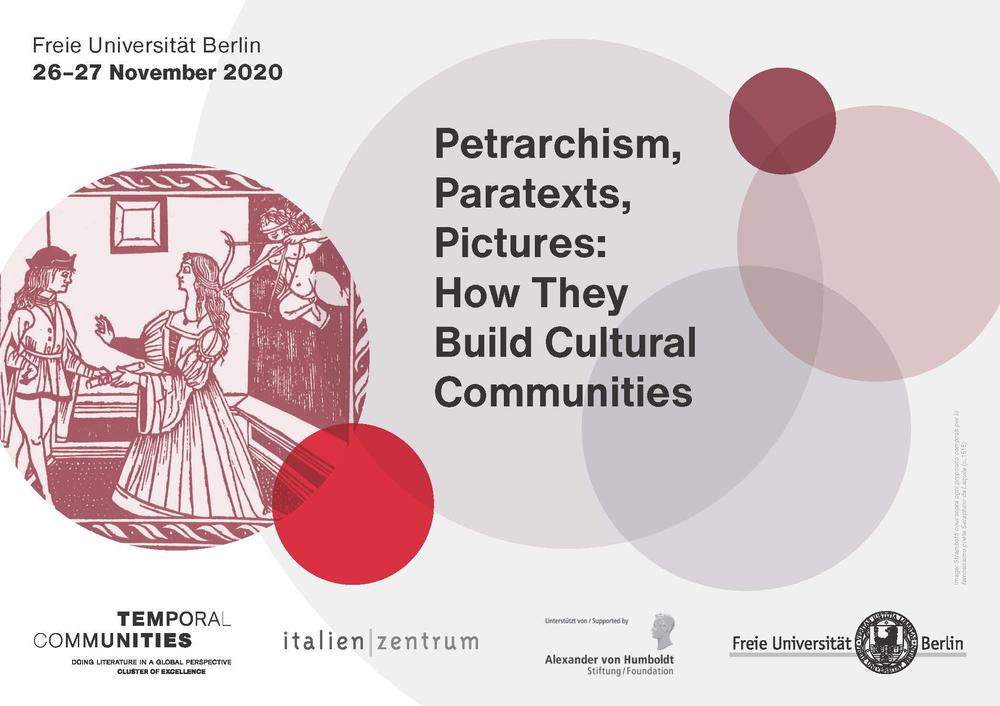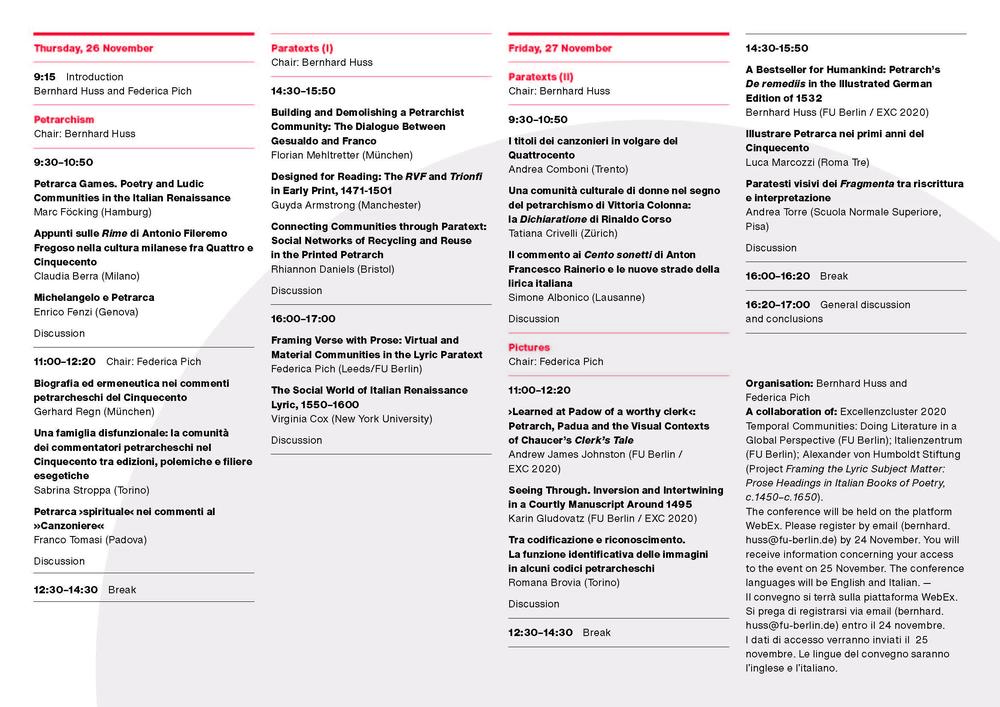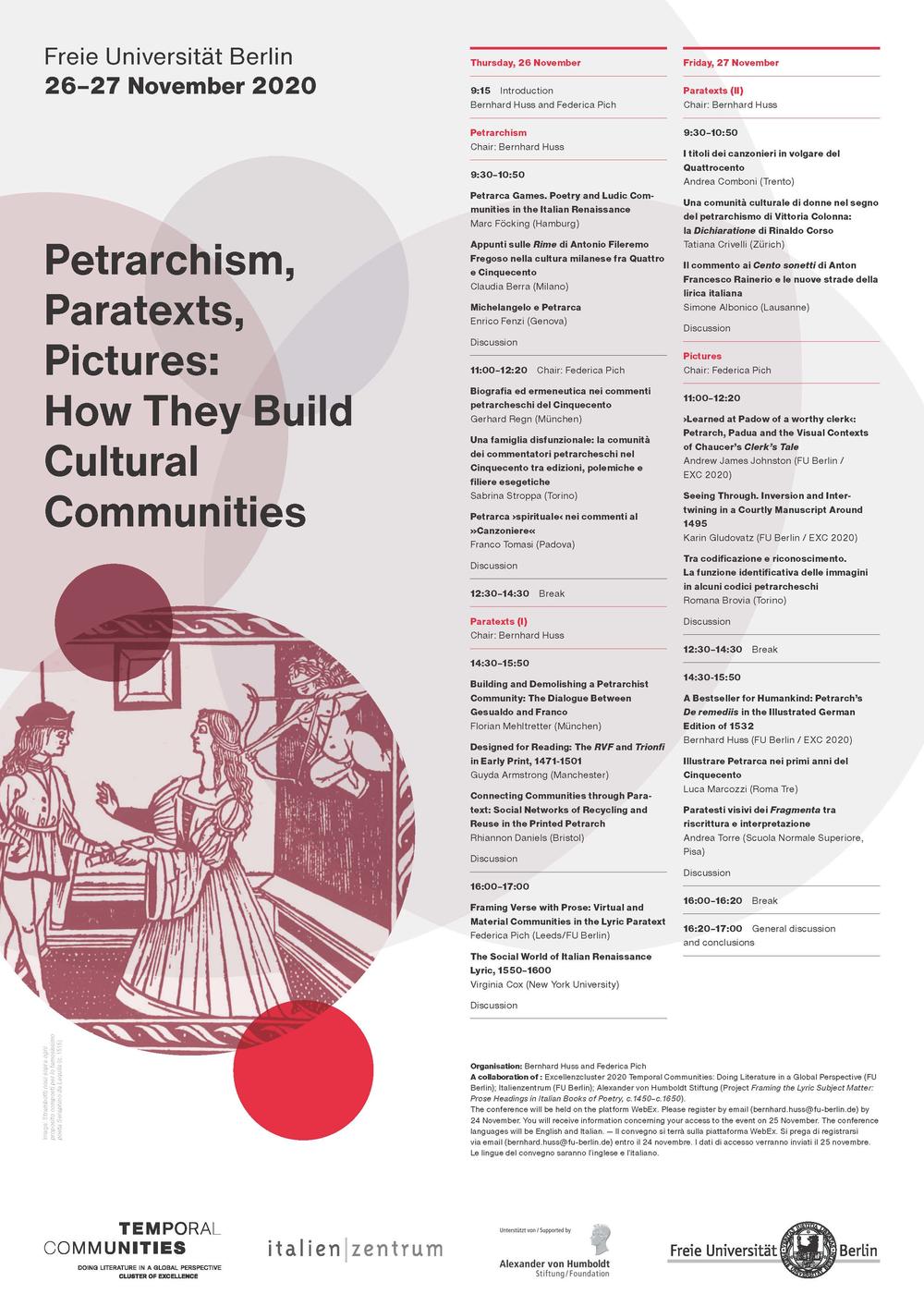Flyer Petrachism, Paratexts, Pictures Seite 1
Flyer Petrachism, Paratexts, Pictures Seite 2
Plakat Petrarchism, Paratexts, Pictures
Conferenza internazionale
Organizzazione: Federica Pich (University of Leeds / Freie Universität Berlin) eBernhard Huss
Altri partecipanti: Simone Albonico (Université de Lausanne), Guyda Armstrong (The University of Manchester), Claudia Berra (Università degli Studi di Milano Statale), Romana Brovia (Università degli Studi di Torino), Andrea Comboni (Università di Trento), Virginia Cox (New York University), Tatiana Crivelli (Universität Zürich), Rhiannon Daniels (University of Bristol), Enrico Fenzi (Università degli Studi di Genova), Marc Föcking (Universität Hamburg), Karin Gludovatz (Freie Universität Berlin), Andrew James Johnston (Freie Universität Berlin), Luca Marcozzi (Università degli Studi di Roma Tre), Florian Mehltretter (Ludwig-Maximilians-Universität München), Gerhard Regn (Ludwig-Maximilians-Universität München), Sabrina Stroppa (Università degli Studi di Torino), Franco Tomasi (Università degli Studi di Padova) e Andrea Torre (Scuola Normale Superiore di Pisa)
In italiano e inglese
Il convegno si terrà sulla piattaforma WebEx. Si prega di registrarsi via email (bernhard.huss@fu-berlin.de) entro martedì, 24 novembre. I dati di accesso verranno inviati il 25 novembre.
In cooperazione con EXC 2020 "Temporal Communities" e la Fondazione Alexander von Humboldt
The conference will investigate the multiple and wide-ranging ways in which the reception of Petrarch informed the building of cultural communities in the Renaissance. The discussion will move from two main interconnected cores, concerning respectively:
(1) the different contexts, institutions and spaces in which Petrarch was read, interpreted and rewritten (such as, among others, academies, courts, and nunneries);
(2) the main media involved in the Renaissance circulation and reception of his works (manuscripts, printed editions, illuminations, woodcuts, emblems).
Particular attention will be paid to the connections between given socio-cultural environments and the fortune of specific editorial formats, visual features or interpretive stances, highlighting the vital relationship between the material and intellectual dimensions of cultural objects and the expectations and practices of the communities that produced and used them. In order to reflect the centrality of this aspect, the conference will be organised around three main concepts/themes:
• Petrarchism (in a broad sense, not strictly limited to poetry);
• Paratexts (both in the Petrarch commentary tradition and in the lyric genre);
• Pictures (visual responses to Petrarch's Latin and vernacular works in manuscripts, printed editions, in the emblematic tradition and in the figurative arts).
The conference is organized as a cooperation of the Cluster of Excellence "Temporal Communities. Doing Literature in a Global Perspective", more specifically its landmark project "Petrarchan Worlds" in Research Area 1 "Competing Communities", the Italienzentrum of Freie Universität Berlin and the Alexander von Humboldt Foundation. Indeed, the section of the conference devoted to paratexts will be co-sponsored by the Alexander von Humboldt Foundation, through Dr Federica Pich's project Framing the Lyric Subject Matter: Prose Headings in Italian Books of Poetry (c. 1450-c.1650). The project, which was awarded an Alexander von Humboldt Fellowship for Experienced Researchers (2019-21) and is carried out at FU Berlin, aims to provide a close study of paratextual elements such as rubriche, argomenti and dichiarazioni in an extensive corpus of Renaissance libri di rime, and to compare their features and uses to those attested in Petrarch commentaries and editions.


